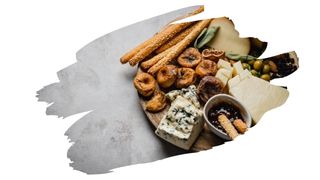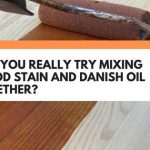When it comes to any food prepping surface, food safety needs to be your first priority.
Now, a quality oil-based wood stain can be a great way to give plain lumber an eye-popping look. Yet, they can also seal the pores of wood too.
And when it comes to cutting board maintenance, that’s the last thing you need.
So, in this post, you will learn the difference between food safe and food grade — and why it matters for cutting boards. You’ll also discover which wholly natural food also makes for a great food-grade stain.
And keep reading to learn why a pure food grade wood finish is the only thing that should saturate your cutting board.

This post may contain affiliate links to products that we receive a commission for (at no additional cost to you). Learn more here.
What Kind Of Wood Stain Do You Use On A Cutting Board?
As a general rule of thumb, you shouldn’t use any stain at all.
That’s because a cutting board is a food prepping surface, meaning that it’ll have direct contact with food. So, wood stains, (even food safe ones), aren’t suitable for a cutting board.
On top of that, wood stains effectively seal over wood pores.
Typically made from a blend of varnish binders and color pigments, wood stains seal up the pores of wood. Which means they can prevent wood finishes — such as mineral oil — from soaking down into that cutting board.
But I Really Want To Add A Bit Of Color To My Chopping Block. So How Do You Darken A Cutting Board?
Honestly, the best way to do this is through wood selection. Use darker toned lumber, such as Roasted Maple wood, if you want a more colorful board.
You see, staining a cutting board isn’t a good idea, food safety-wise. But, if you want to make a purely decorative cutting board, you can feel free to stain it.
In short, only use food grade finishes on a chopping block.
And What Is The Difference Between Food Safe And Food Grade?
Well, food safe finishes/stains contain toxins and chemicals that are not safe for human consumption.
However, once they’ve dried and cured into a solid film, they no longer leech any of those chemicals. And this makes them safe enough to coat surfaces and walls in kitchen/dining settings.
Related Post: Can Polyurethane Be Safely Used On Charcuterie Boards?
Yet, these food safe finishes/stains are not wholly insurmountable.
Some wood stains can become damaged by alcohol or vinegar. And other durable food safe sealers can become sliced up by your sharp chopping kitchen utensils.
Which means that if these food safe finishes come into contact with your food, you run the risk of them getting into your next meal. And that is not good for your health.
However, a food grade finish/stain is completely non-toxic — so much so, that it’s safe enough for human consumption.
These food grade finishes aren’t as durable as food safe ones. Nevertheless, if they get into your food, you needn’t worry about them making you ill.
But Is There A Food Grade Wood Stain For Cutting Boards?
A food grade wood stain is one that’s made from non-toxic ‘safe-for-consumption’ ingredients.
And there is one such type of food grade wood stain that’s both cheap and easily accessible: Coffee!
Wait A Second…Can You Really Use Coffee As A Wood Stain?
Well, first off, coffee works wonderfully as a wood stain. What’s more, unlike oil-based stains, it doesn’t need a binding ingredient (such as varnish) to add color to wood.
So using coffee to stain wood means that you won’t seal over wood pores. And this, in turn, makes it easy to apply a penetrating wood finish (such as mineral oil) over it.
But, this food grade stain isn’t the best option for cutting boards either, for two good reasons:
1). Coffee Is Not A Durable Wood Stain
While coffee can add rich color to light-color timbers, it isn’t a long-lasting stain. It’s lack of a durable binding ingredient means that coffee-stained color will fade within a month.
So, if you want to maintain it’s color, you are going to have to reapply this coffee stain repeatedly.
2). Coffee Can Go Moldy
Coffee is an actual food that is more than capable of going bad and growing mold.
So, to protect that coffee stain color, you need to seal it with a watertight wood sealer.
That sealant will prevent moisture from saturating the coffee. This is important, because combined they make an ideal environment for mold bacteria.
But it’s sort of a catch-22 situation. Coffee stained wood needs to be sealed up tight with a durable waterproofing sealant. However, regularly used cutting boards should not be wrapped up in those kinds of sealants.
So, for practical reasons, it’s best you leave that cutting board unstained — and simply stick to woods natural color.
OK…And What Kind Of Finish Can I Use On A Cutting Board?
Use a food grade non-drying oil — such as 100% pure food grade mineral oil — to finish a cutting board.
And avoid applying wood stains onto direct-food-contact surfaces, such as chopping blocks and charcuterie boards.
Related Post: What Type Of Wood Finish Is Best Used On A Charcuterie Board?
To Wrap Up, Here Are The 3 Key Takeaways From This Post…
- 1). Food safe wood stains can be used to add color to wooden surfaces in kitchen settings, such as countertops and tables.
- 2). However, a food safe wood stain is only suitable for indirect contact with food. It should not be applied onto surfaces that will have direct contact with food (i.e. cutting boards).
- 3). Add ‘color’ to your cutting board beforehand by making your board with darker-toned lumber.

![Will Tacky Wood Stain Eventually Dry? [What To Do When Stain Is Not Drying] will tacky stain eventually dry](https://www.thewoodworkplace.com/wp-content/uploads/2022/10/Banner-502-150x150.jpg)

